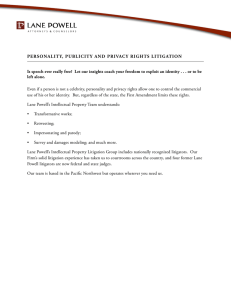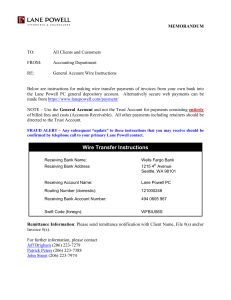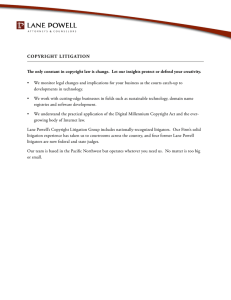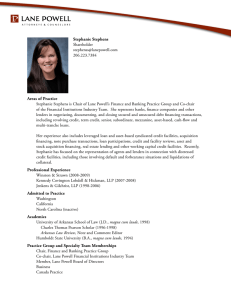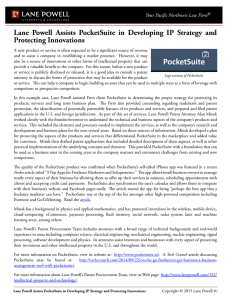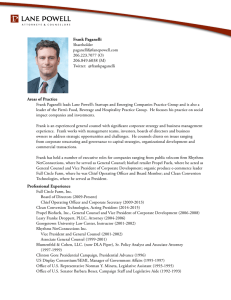Dodging Deal Killers Anticipating and Solving Problems Related to Properties
advertisement
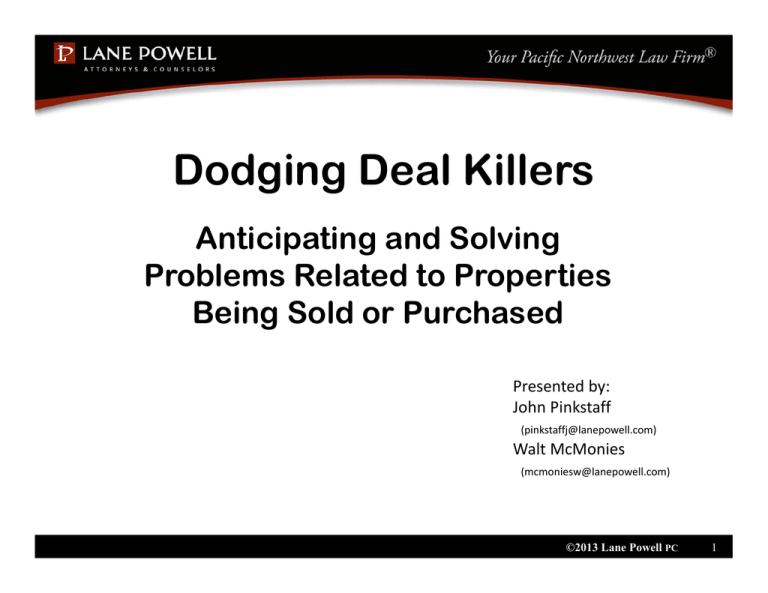
Dodging Deal Killers Anticipating and Solving Problems Related to Properties Being Sold or Purchased Presented by: John Pinkstaff (pinkstaffj@lanepowell.com) Walt McMonies (mcmoniesw@lanepowell.com) ©2013 Lane Powell PC 1 TABLE OF CONTENTS 1. 2. 3. 4. 5. 6. 7. 8. 9. 10. 11. 12. 13. 14. Contamination; Environmental Issues Defective or Incomplete Land Use Approval “As Is,” “Your Problem Not Mine” Seller Encroachment URM or Otherwise Seismically Challenged Property Use, Alterations and Redevelopment of Existing Buildings CC& R Restrictions Legal Access Soils or Riparian Issues Flood, Tsunami, Storm/Wind Vulnerability Prohibitive Prepayment Penalty Under-Performing Property Low Basis Seller Investor Gets “Cold Feet;” Need $$ to Close ©2013 Lane Powell PC 2 Dodging Deal Killers Introduction Sellers: Don’t hide a problem; disclose it. Buyers: Look under every rock and get appropriate contingencies and get Reps and Warranties. Both: Dealing with Property defects: • Find out as much as possible; • Consult an expert; • Develop a plan to cure or minimize; • Ascertain the approximate cost and timetable to implement the plan; and • Implement the plan pre-closing if possible; or • Negotiate a price reduction or buyer holdback or credit against the purchase price to compensate for taking the Property with the defect. ©2013 Lane Powell PC 3 1. Contamination; Environmental Issues Problem: • Significant environmental contamination on or directly affecting the Property. • No DEQ or WDE (Washington Dept. of Ecology) “no further action” (NFA) letter. Concerns: • Stepping into major liability for someone else’s mess. • Remediation costly, time consuming and difficult. • Stigma of the contamination will scare off lenders and buyers. • Remediation may interfere with day to day use. ©2013 Lane Powell PC 4 Contamination; Environmental (cont.) Approach to Solution: • Hire an environmental consultant or environmental attorney (for each side). • Obtain any existing Phase One or other documentation on the contamination. • If none, commission a Phase One/Phase Two environmental assessment. • The parties’ consultants should agree on a scope of work and then negotiate with DEQ. • Get bids or estimates to quantify the cost of remediating and the estimated time frame. ©2013 Lane Powell PC 5 Contamination; Environmental/Approach (cont.) • Determine if there is any “deep pocket” third party liable. • Negotiate both (i) a holdback of the remediation cost out of Seller’s closing funds and (ii) potentially an adjustment of the purchase price. • Ensure Buyer’s lender will hold its interest rate on the new loan pending remediation if done pre-closing. • Determine whether insurance may be available to Seller covering his loss. ©2013 Lane Powell PC 6 2. Defective or Incomplete Land Use Approval Problem: • Outstanding and unsatisfied pre-conditions to the original (land use) development approval of the Project. Concerns: • City/County could force compliance at any time and • It may be difficult, costly or impossible to comply. Approach: • Identify all prior land use decisions and conditions of approval. ©2013 Lane Powell PC 7 Defective or Incomplete Land Use Approval/Approach (cont.) • Gather information and documentation re compliance from: – Planning staff. – ALTA surveys and title reports. – Zoning reports such as PZR Reports. – City/County file review. – History, marketing materials, development files. ©2013 Lane Powell PC 8 Defective or Incomplete Land Use Approval/Approach (cont.) • Evaluate materiality of outstanding/unsatisfied condition of development approval. – Fatal non-compliance. – Non-fatal non-compliance. – Confer with Lender’s counsel on situation. • If material, evaluate feasibility of obtaining retroactive compliance pre vs. post-closing. ©2013 Lane Powell PC 9 3. “As Is,” “Your Problem Not Mine” Seller Problem: Seller who: • Insists on selling the Property entirely on an “AS IS” basis; • Refuses to make any representations or warranties; and • Either has inadequate files or refuses to allow Buyer to review his files. Concerns: Seller likely suspects or knows there is a major defect in the Property. ©2013 Lane Powell PC 10 As Is (cont.) Approach • Some minimal Representations (“Reps”) are expected of Seller: – Has marketable title; – Seller entity authorized to sell; – Knows of no substantial defects in condition of Property or in land use approvals for its development; – Has received no notices of non-compliance not cured; and – Caveat: Okay for Seller to qualify most Reps. “TB of K.” ©2013 Lane Powell PC 11 As Is/Approach (cont.) • AS IS language acceptable as long as: – Buyer is given access to and an opportunity to copy all Seller’s files (excepting tax returns); and – Seller represents that the files are substantially complete and accurate. • Presence of a strong AS IS disclaimer – Forces meticulous and thorough due diligence. – Necessitates a longer contingency period. ©2013 Lane Powell PC 12 As Is/Approach (cont.) • Terminate if Seller won’t either: – Allow file access; or – Give a Rep or Warranty that there are no substantial undisclosed defects. • The AS IS clause, etc., should be vetted by each party’s attorney. ©2013 Lane Powell PC 13 4. Encroachment Problem: Project buildings or improvements encroach on a Property boundary line, into a required setback or recorded easement way. Concern: Cloud on title and potentially a loss of use and financial. Approach: – Cure the encroachment by demolition of the improvement; – Payment in settlement; or – Litigation with neighbor. ©2013 Lane Powell PC 14 Encroachment /Approach (cont.) • Don’t have to straddle the Property boundary to encroach. – An improvement can encroach on an access or utility easement or it can encroach on and thereby violate a setback. – Whatever, need to have a surveyor draw and measure. – Encroaching into a zoning setback is a problem, but can often get a retroactive variance/adjustment. – A setback imposed by CC&R’s may be a bigger problem. ©2013 Lane Powell PC 15 Encroachment/Approach (cont.) – When an encroachment is in the form of improvements built over a utility easement, Seller may have to move the improvements. – Find out if the easement is still in use or has been abandoned. – Query, whether Seller had an encroachment endorsement on his title policy when purchased? ©2013 Lane Powell PC 16 Encroachment/ Approach (cont.) • Boundary line encroachments. Consider: – Work with title examiner to clear up boundary line overlaps/gaps. – Confer with County Surveyor re encroachments identified by a survey. – Compliance with County/City ordinances prohibiting recording of surveys evidencing boundary line encroachments. – Need a property line adjustment, easement, or boundary line agreement with adjacent property owner to resolve encroachment. ©2013 Lane Powell PC 17 5. URM or Otherwise Seismically Challenged Property Problem: • Where the building(s) are of unreinforced masonry (“URM”) or other seismically deficient construction; and/or • Where located in a seismically vulnerable area or on unstable soils. Concerns: If a URM: • Can’t get advantageous Freddie Mac, Fannie Mae, “Conduit,” and Chase loans. ©2013 Lane Powell PC 18 URM/Concerns (cont.) • What loans are available (often from Banks) will: – have a lower LTV ratio and higher DSC; – higher interest rate; – shorter rate-fixed period; – shorter amortization; and – will require personal guarantees. • Earthquake insurance, if available: – Will be surplus lines only (less regulated); – Have higher deductibles; – Have less breadth of coverage; and – Will be more expensive. ©2013 Lane Powell PC 19 URM /Concerns (cont.) • Building inspector might force major seismic upgrades if it is determined: – a dangerous building; – substantial work being done; or – there is a “change of use.” • Building potentially dangerous to tenants, – discouraging occupancy; and – creating possible tort liability for the owner. ©2013 Lane Powell PC 20 URM (cont.) Comment: • It is technically feasible to seismically upgrade most URMs and seismically deficient buildings. • Financial feasibility is a reflection of both the cost of the seismic upgrade and the rental value of the renovated space. – Portland has high rents, high seismic risk vs. (say) Pendleton with low rents and low risk. ©2013 Lane Powell PC 21 URM (cont.) Approach: • Determine if the building is a URM/seismically challenged. – Portland has a circa 1991 City Engineer’s inventory. • Determine whether the building is in a seismic risk area. – The Oregon Coast is in Seismic Zone 4 and most of the 1-5 corridor is in Seismic Zone 3 or 4. – Consult the Oregon Dept. of Geology (“DOGAMI”) webpage to learn of any nearby faults and unstable soils. • If a URM or inadequately reinforced, consider having an engineer perform an ASCE 31 or an ASCE 41 analysis and get a “PML” (Probable Max Loss) calculation. ©2013 Lane Powell PC 22 URM/Approach (cont.) • If the Building of historic quality, significant tax incentives may apply, e.g. – Oregon’s 10 year historic property tax assessment freeze; – The Federal 20% historic tax credit; and – A charitable façade donation. • Portland is fairly flexible about seismic upgrades especially for historic properties. See Portland CC 24.85. ©2013 Lane Powell PC 23 URM/Approach (cont.) • To determine if seismic upgrading is financially feasible: – Obtain upgrade design proposals and preliminary bids from several masonry contractors. – Project the post construction income and expense of the Building. • Result: Reduce purchase price to reflect earthquake risk and upgrade cost. ©2013 Lane Powell PC 24 6. Use, Alterations and Redevelopment of Existing Buildings Concerns: • Before committing to acquire a project, perform due diligence re: building permits, proposed use, alterations, change of use or redevelopment of the building. Approach: • Check all permits in the Building Department’s file and consult with City/County Planning Dept. – Copies of building permits, formal PreApplication Conference, informal assistance, written report from City/County planning staff. ©2013 Lane Powell PC 25 Use, Redevelopment (cont.) – If work appears to have been performed after original construction, check to be sure it was permitted. – If not permitted, retain a competent engineer or architect to negotiate with the Building Department to get the work permitted. – Uniform Building Code violations, problems: oPlumbing, electrical or structural work done without a permit, may be defective, dangerous and could “red tagged” at any time; oLender may refuse to loan until situation rectified; and oCasualty insurer may refuse to insure. ©2013 Lane Powell PC 26 Use, Redevelopment/ Approach (cont.) – Illegal Units o Apartment complex has unpermitted (“illegal”) units (e.g. common area converted to units) and Seller thinks the illegal units are worth the same as legal ones. o Consult an architect and/or city/county planning departments re legality of units and what is needed legalize units. o Price of the illegal units should be discounted to reflect the time, money and risk won’t be able to make legal. ©2013 Lane Powell PC 27 Use, Redevelopment (cont.) – Exactions o Governing Law: Whether condition of development requiring dedication of land is an unconstitutional “taking” under U.S. Constitution based on Nolan/Dolan analysis requiring condition have requisite “nexus” and “proportionality” to impact from development. o Exactions distinguished from requirement that owner undertake monetary obligation for off-site improvements. ©2013 Lane Powell PC 28 Use, Redevelopment (cont.) – Legal lot determination o Governing Law o Legal lot and permitted use distinguished o Establishment – Change of Use o Governing law o Establishment ©2013 Lane Powell PC 29 Use, Redevelopment (cont.) – Nonconforming Use (NCU) o Governing Law o NCU and Vested Rights distinguished o Establishment and Scope – Nonconforming Development o Governing Law o Nonconforming Development and NCU distinguished o Establishment and Scope ©2013 Lane Powell PC 30 Use, Redevelopment/ Approach (cont.) – Outdoor Signs/Cell Towers/Roof Antenna oValue of lease vs. limitations on future use. oReview lease terms. oNegotiate termination of lease if necessary. ©2013 Lane Powell PC 31 7. CC& R Restrictions Problem: • Title clouded by 70 years or older (pre-WW II) CC & R’s imposing: – Ethic, religious and/or racial restrictions on ownership or occupancy (generally unenforceable) as well as. – Density and/or height limitations, minimum square footage of improvements, minimum lot size, stringent setbacks, design review and/or limited approved uses (generally enforceable). ©2013 Lane Powell PC 32 Old CC & R’s/Approach: Concern: Uncertainty whether enforceable. • Constitutionally unenforceable restrictions against ownership or occupancy by individuals of various racial and ethnic groups NOT THE ISSUE. • Other restrictions are likely enforceable: – Limiting uses allowed beyond applicable zoning; – Imposing larger set-backs than applicable zoning; – Imposing minimum lot and house/ building size; – Specifying construction materials and design; or – Imposing design review. ©2013 Lane Powell PC 33 Old CC & R’s/Approach (cont.) • Some restrictions can we waived: – If benefitted parties consent in writing; or – If the benefitted parties have tacitly or formally waived their rights. • Consult an attorney or title company to determine benefitted owners. ©2013 Lane Powell PC 34 8. Legal Access. Problem: • Project lacks adequate legal access to arterial street (an authorized “curb cut”), or extent of current access diminished due to state, county or city policies or permit conditions. Concerns: • Bad access diminishes building value; no access eliminates value. • Can be difficult and expensive to negotiate access if you don’t have it. ©2013 Lane Powell PC 35 Legal Access (cont.) Approach: • Consult a land use attorney and traffic consultant/engineer if necessary. • If lack legal access, Query: did the Seller have an access endorsement on the title policy received at purchase? • Consult with appropriate road jurisdictions. – City streets or County roads. Talk with City or County Transportation Dept. about Transportation Plan and policies and access permits. ©2013 Lane Powell PC 36 Legal Access/Approach (cont.) – State highways. Talk with Regional Office of Oregon Department of Transportation (ODOT) re ODOT access permit. oODOT may require combining driveway cuts for adjoining parcels with same owner. oODOT may eliminate street parking and loading zones. ©2013 Lane Powell PC 37 Legal Access/Approach (cont.) oRecent changes in state laws and ODOT regulations affecting state highway access ORS 374.310 and 374.312, as amended by SB 1024 (2010) re access based on objective standards and less stringent access management rules, measures and spacing and mobility standards; and SB 264 (2011) changed process based on objective standards and procedural changes. ©2013 Lane Powell PC 38 Legal Access/Approach (cont.) ODOT Access Rules now provide the following: Reasonable access based on economic development needs; Safety based on Objective Standards; Change of Use based on spacing, channelization, and site distance standards; ODOT has burden of proving problems; and Approval with deviations from spacing, channelization and sight distance. Expedited permitting. New appeals process with collaborative and dispute review process. ©2013 Lane Powell PC 39 9. Soils or Riparian Issues Concerns: • The Property has soils issues, e.g. – The Property or immediate uphill neighbor’s Property is on an unstable slope prone to landslides; or – Building is built on an old creek bed predisposed to liquefying in an earthquake; and/or – The creek is still active, periodically flooding the Building’s basement. • Or, there are apparent wetlands or riparian areas. • Any of these soils issues may be difficult or very expensive to solve. ©2013 Lane Powell PC 40 Soils or Riparian Issues (cont.) Approach: • Consult a soils/geotechnical engineer and test. • If a limited but important area has unstable soils, one has options, including the installation of “mini pilings” or infusing the sub soil with very liquid concrete. • Any suspected riparian area should be inspected by a biologist or other riparian specialist. • In some situations, a compromised riparian area may be eliminated in exchange for mitigation in the form of riparian credits acquired from another property. ©2013 Lane Powell PC 41 10. Flood, Tsunami, Storm/Wind Vulnerability Problem: Some structures on the Property are: • In the 100 year floodplain; • In a tsunami evacuation/ impact zone; or • Are surrounded by large, diseased or surface rooted trees, making them vulnerable to windstorm “blow down.” ©2013 Lane Powell PC 42 Flood, Tsunami, Storm/Wind Vulnerability (cont.) Approach: • Obtain flood inundation maps from the FEMA. – Engage engineer if within Flood Hazard Area to consider: Federal, State, County, City permits; FEMA Elevation Certificate; “No Net Rise” Certificate; and “Balanced cut & fill.” ©2013 Lane Powell PC 43 Flood/Approach (cont.) • Obtain tsunami evacuation maps from DOGAMI and/or NOAA. – If the Property is below 50 feet above sea level on the Oregon Coast, risk high. • Check with the National Weather Service on records for high winds. – Wind risk compounded by overhanging trees. If possible, cut down or prune offending trees. ©2013 Lane Powell PC 44 Flood/Approach (cont.) • Obtain flood, tsunami, earth movement or wind storm casualty insurance, often in the form of a “DIC” policy (Difference in Condition). – Often this type of coverage is limited in scope, has high deductibles and has a fairly low maximum payout. – Sometimes deductible must be exhausted be for any payment due. – Written on a “surplus lines basis,” meaning that the insurer deals in high risk policies and is not regulated by the state (either as to rates charged or risk taken). ©2013 Lane Powell PC 45 11. Prohibitive Prepayment Penalty Problem: • Seller has a prohibitively large prepayment penalty on his existing mortgage loan. • Often a “yield maintenance” formula applies, but is really “yield enhancement” as assumes lender can only reinvest the repayment at same term T-Bill or similar low rates – Ignores the 200 bp or larger spread above the index. ©2013 Lane Powell PC 46 Prohibitive Prepayment Penalty (cont.) Questions: • Does Seller have a right of “defeasance” of the existing mortgage loan? – i.e. the right replace the Property as collateral with a basket of T-Bills paying the same income stream? • If not, does the Seller have a right of “assumption,” i.e. to sell the Property and have the Buyer assume to existing financing? • Assumption made unattractive when (i) the Lender is unwilling to release the Seller or when (ii) the existing mortgage loan is (say) only a 50% LTV such that Buyer will need secondary financing. ©2013 Lane Powell PC 47 Prohibitive Prepayment Penalty (cont.) Approach: • Get an estimate of the actual prepayment penalty at a target closing date and assuming a certain market interest rate. Have your accountant check calculation. • Will Lender will forgive some or all of the penalty if the Buyer, rather than assuming the existing loan, obtains a new acquisition loan from Lender? • Any leverage to avoid the prepayment penalties because Lender has misrepresented something or misbehaved? ©2013 Lane Powell PC 48 Prohibitive Prepayment Penalty/Approach (cont.) • If defeasance is an option, how costly? • If defeasance is cost effective, retain a defeasance consultant and an attorney experienced with defeasance (as legal opinions typically required). • Beware: Likely a default to bypass the Lender with “wraparound” financing. ©2013 Lane Powell PC 49 12. Under-Performing Property Problem: • The Property has been poorly managed and has below market rents, substandard tenants, a high vacancy rate and much deferred maintenance. • The Property’s current net operating income (“NOI”) is too low to allow a 65% to 70% loan especially with lenderimposed repair reserves, i.e. Property will not meet the required “debt service coverage” ratio (say) 1.35 to 1. ©2013 Lane Powell PC 50 Under Performing Property (cont.) Solution: • Negotiate a Master Lease/Option of the Property from Seller. – Stated Term (say) 5 years, but in reality Buyer intends to exercise the option within a year. – Seller will want a large option payment (say 1025% of the sale price) but Buyer protected as all applies to the purchase price. – Rent, on a “triple net” basis, the monthly rent payment to be approximately equivalent to a mortgage payment for the remainder of the sale price (after deduction the option payment). ©2013 Lane Powell PC 51 Under Performing Property/Solution (cont.) – Option to purchase that expires in (say) 9-12 months. – Buyer/ Lessee given authority to: • renovate the property; • cure deferred maintenance; • evict unsatisfactory tenants assuming on month-to-month rental; • raise tenant rents as allowed; and • tighten financial controls on property operation. ©2013 Lane Powell PC 52 Under Performing Property/Solution (cont.) – Goal: in 9 to 12 months, to increase the NOI and the appraised value so that will be able to get 65-75% loan at a favorable interest rate. – Note: Seller cannot have a right to compel purchase or else he will risk a “deemed sale” in eyes of IRS on lease execution. – An advantage: Seller has 9-12 extra months to find a Section 1031 exchange “replacement” property. ©2013 Lane Powell PC 53 13. Low Basis Seller Problem: • Seller has a low tax basis in the Property, which will result in a large taxable gain to him on the sale. Approach: • Make the sale contingent on Seller accomplishing a IRC Section 1031 tax deferred exchange. • “Replacement” properties need to be sufficient in cost to allow equivalent debt and an equity payment sufficient to absorb all Seller’s cash proceeds from the sale. • An additional wrinkle: Seller may need a large nonrefundable earnest money deposit to tie up his replacement Property. ©2013 Lane Powell PC 54 Low Basis Seller (cont.) Specific Steps: • If an exchange, defer gain recognition. • To qualify need: – To employ an exchange accommodator (“Qualified Exchange Intermediary”); – To take no proceeds, all going to the accommodator; – To identify replacement properties within 45 days of sale and close within 180 days; and – To have adequate funds to tie up the replacement property. ©2013 Lane Powell PC 55 Low Basis Seller/Specific Steps (cont.) • Structure the PSA for the sale of “relinquished” property so that accommodator receives from Buyer a large non-refundable earnest money deposit which the accommodator can in turn deposit in the escrow as an earnest money deposit on the “replacement” property. • Draft the PSA for the replacement property with an exchange contingency so that the deposit is refundable if Seller’s (the tax payer) sale fails. ©2013 Lane Powell PC 56 14. Investor Gets “Cold Feet”; Need $$ to Close Problems: • Buyer’s major investor, intending to contribute (say) 50% of the equity capital for the purchase, gets “cold feet,” such that Buyer needs either a replacement investor or else needs subordinated/ mezzanine debt to provide the needed cash to close. • Also, Lender must bless the new investor or subordinated debt Lender. ©2013 Lane Powell PC 57 Investor gets Cold Feet (cont.) Options for Buyer: • Terminate the transaction without forfeiture if have broadly phrased “financing” contingency; • Terminate the transaction, but forfeit the earnest money deposit if no suitable and un-waived contingency applies; • Get an extension from Seller and attempt to find a substitute investor by, if necessary, providing the investor a preferred return [Note: securities law issues]; • Obtain subordinated financing from a mezzanine or “hard money” lender, assuming your 1st mortgage lender approves; or • Flip the deal to a new buyer if PSA assignable. ©2013 Lane Powell PC 58
